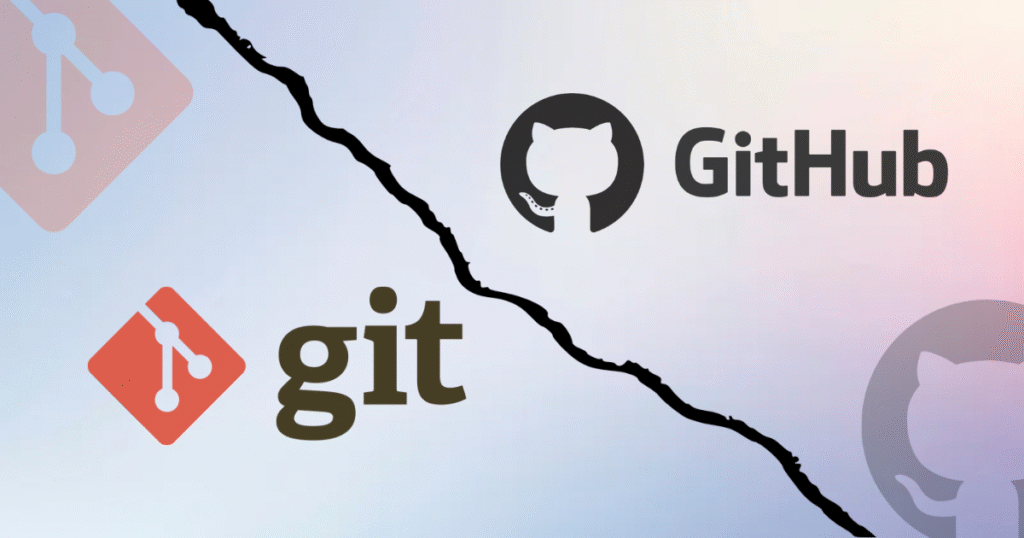Git vs GitHub: Understanding the Key Differences

In the world of software development, Git and GitHub are two terms that often come up, especially when discussing version control and collaborative coding.Although they are interconnected, each serves a unique function. This article dives deep into the differences between Git and GitHub, explaining their functionalities, use cases, and how they complement each other. Whether you’re a beginner or an experienced developer, understanding these tools is essential for efficient project management and collaboration. What is Git? Git is a decentralized version control system created to monitor changes in source code throughout the software development process. Developed by Linus Torvalds in 2005, Git enables multiple developers to collaborate on a project without conflicting changes. It is a command-line tool (though GUI tools exist) that records the history of changes in a project, enabling developers to revert to previous versions, branch out to experiment with new features, and merge changes seamlessly. Key Features of Git Git operates locally on your computer, meaning you don’t need an internet connection to commit changes, create branches, or view project history. It’s a powerful tool for managing code versions, but it lacks a centralized platform for collaboration unless paired with a hosting service. What is GitHub? GitHub is a cloud-based platform that hosts Git repositories, making it easier for teams to collaborate on projects.Introduced in 2008, GitHub enhances Git’s version control system with features such as remote repository hosting, collaboration tools, and an intuitive interface. It’s widely used by developers, open-source contributors, and businesses to manage codebases, track issues, and automate workflows. Key Features of GitHub Unlike Git, GitHub requires an internet connection to access repositories and use its features. It’s not a version control system itself but a platform that enhances Git’s capabilities for collaborative development. Git vs GitHub: The Key Differences To clarify the distinction, here’s a breakdown of the key differences between Git and GitHub: Aspect Git GitHub Definition A distributed version control system designed to track changes in code. A cloud platform designed for hosting and collaborating on Git repositories Functionality Manages code versions locally using commands like commit, branch, and merge. Offers a user interface for handling repositories, collaboration, and automation Usage Command-line tool (or GUI clients) installed on your computer. A browser or GitHub Desktop can be used to access this web-based platform. Internet Dependency Works offline; no internet required for local operations. An internet connection is needed to access repositories and their features. Collaboration Limited to local sharing or manual repository syncing. Enables seamless collaboration with pull requests, issues, and team tools. Cost Free and open-source. Available for free with public repositories; paid plans are offered for private repositories and additional features. Storage Stores repositories locally on your machine. Stores repositories in the cloud. How Git and GitHub Work Together Git and GitHub are vital tools that collaborate to enhance modern software development workflows. Local Work with Git: A developer uses Git on their computer to create a repository, commit changes, and manage branches. For example, they might use commands like:git init git add . This synergy allows developers to leverage Git’s powerful version control locally while using GitHub’s collaboration and hosting features to work as a team. Why Use Git and GitHub? Benefits of Git Benefits of GitHub Common Use Cases Git Use Cases GitHub Use Cases Alternatives to GitHub While GitHub is the most popular platform for hosting Git repositories, alternatives exist: Both platforms offer unique advantages, but GitHub’s vibrant community and extensive ecosystem often make it the preferred option for developers. Getting Started with Git and GitHub Setting Up Git Set up Git: Configure your name and email for commit identification.git config –global user.name “Your Name” Setting Up GitHub Link Local and Remote: Connect your local Git repository to GitHub using:git remote add origin <repository-URL> Best Practices for Using Git and GitHub Conclusion To summarize, Git is a version control system that tracks local code changes, whereas GitHub is a platform that hosts Git repositories and facilitates collaboration. Together, they provide a robust toolkit for developers, ensuring effective version control and smooth teamwork. By understanding their differences and leveraging their strengths, you can streamline your development workflow and contribute to projects of any scale. Whether you’re working solo or with a team, mastering Git and GitHub is a valuable skill in today’s tech landscape. Start experimenting with Git locally, explore GitHub’s collaborative features, and join the global developer community to take your coding journey to the next level.
What Is the AI Action Figure Trend? Here’s Why Everyone’s Talking About It

In a digital age where personal branding, artificial intelligence (AI), and creativity converge, a new trend is making waves: AI-generated action figures for personal branding. These aren’t your typical collectibles. Instead, they represent a unique fusion of technology, identity, and marketing. Social media feeds are now brimming with stylized toy-like representations of professionals, entrepreneurs, and influencers, designed using AI tools. But what exactly is this trend, and why is it gaining so much traction? Let’s dive into the phenomenon known as the AI action figure trend and explore how it’s reshaping the way individuals express their personal brand in the digital world. What Is the AI Action Figure Trend? The AI action figure trend refers to the growing movement of individuals using artificial intelligence-powered design tools (like Midjourney, DALL·E, and ChatGPT) to create digital action figure versions of themselves. These images often depict people in a toy box-style packaging, complete with personalized accessories, taglines, and branding elements that reflect their profession or personality. Think of it as a playful yet powerful visual metaphor: you, as a brand, packaged for the world to see. It’s fun, it’s visually engaging, and it taps into nostalgia while positioning professionals as modern-day icons in their field. Why Is Everyone Talking About It? There are several reasons this trend is gaining momentum, especially among creators, marketers, and entrepreneurs: 1. It Grabs Attention in a Sea of Digital Noise In today’s fast-paced online world, standing out is more important than ever. AI-generated action figures offer a visually striking and imaginative way to do just that. Their vibrant colors, unique designs, and nostalgic appeal make them instantly eye-catching and perfect for sharing on social media. 2. It Reinforces Personal Branding Every professional has a story, a mission, and a skill set. These action figure images encapsulate all that in a creative, cohesive visual. From the outfit to the accessories, every element reflects your brand persona. It’s more than just a trend — it’s a branding tool. 3. It Leverages the Power of AI The process of creating these figures taps into cutting-edge AI tools. Users combine prompts from ChatGPT with visual generators like Midjourney or DALL·E to bring their vision to life. This tech-savvy approach not only shows creativity but also demonstrates familiarity with emerging digital tools — a plus in today’s job market. 4. It Sparks Conversation and Connection People love novelty. When you share your AI action figure, it opens the door to conversations: “How did you make it?”, “That’s so cool!”, “Where can I get mine?” It’s a great icebreaker, networking tool, and brand awareness booster. How Are People Creating Their AI Action Figures? The creation process usually involves a combination of text-based prompting and image generation. Here’s a basic step-by-step breakdown: Step 1: Use ChatGPT to Create a Prompt Start with a prompt that describes your ideal action figure. For example: “Create an image of a confident female entrepreneur in a stylish blazer inside a toy box package. Include accessories like a laptop, marketing book, and coffee cup. Add a tagline like ‘Marketing Boss.’ Use bright, modern colors and a futuristic design style.” Step 2: Input That Prompt into an AI Image Generator Take that prompt and input it into tools like Midjourney or DALL·E. These platforms will transform your vision into a polished, stylized image. Step 3: Customize and Share Once the image is created, you can tweak it with photo editing apps or add text overlays using Canva. Then share it across your platforms with a compelling caption about who you are and what you do. Who Is This Trend For? While it’s especially popular among digital creators, marketers, coaches, and solopreneurs, the trend is truly universal. Anyone looking to stand out and make a creative impression online can benefit from this fun branding experiment. Whether you’re a tech founder, a motivational speaker, a fashion designer, or even a corporate executive, there’s room for your unique action figure version in the spotlight. The Psychology Behind the Popularity Part of the magic behind this trend lies in its psychology. Humans are naturally drawn to play, nostalgia, and storytelling. The action figure taps into all three: Combined with the futuristic appeal of AI, this blend of old and new is incredibly magnetic. SEO and Personal Branding Benefits From an SEO and branding perspective, these action figure images serve several purposes: By tagging your post with relevant keywords like #AIbranding, #PersonalBranding, #ActionFigureTrend, and including strong captions, you can increase discoverability and reach. Final Thoughts: Is It Just a Fad? While it might seem like a fun gimmick at first glance, the AI action figure trend taps into something deeper: the desire to be seen, remembered, and differentiated in a digital world that often feels crowded and impersonal. As AI becomes more accessible and personal branding continues to evolve, expect this trend to stick around in new forms — from interactive avatars to virtual merchandise and beyond. So, whether you’re hopping on this trend for fun or using it as a strategic branding move, one thing’s for sure: the AI action figure is more than a toy — it’s a statement.
